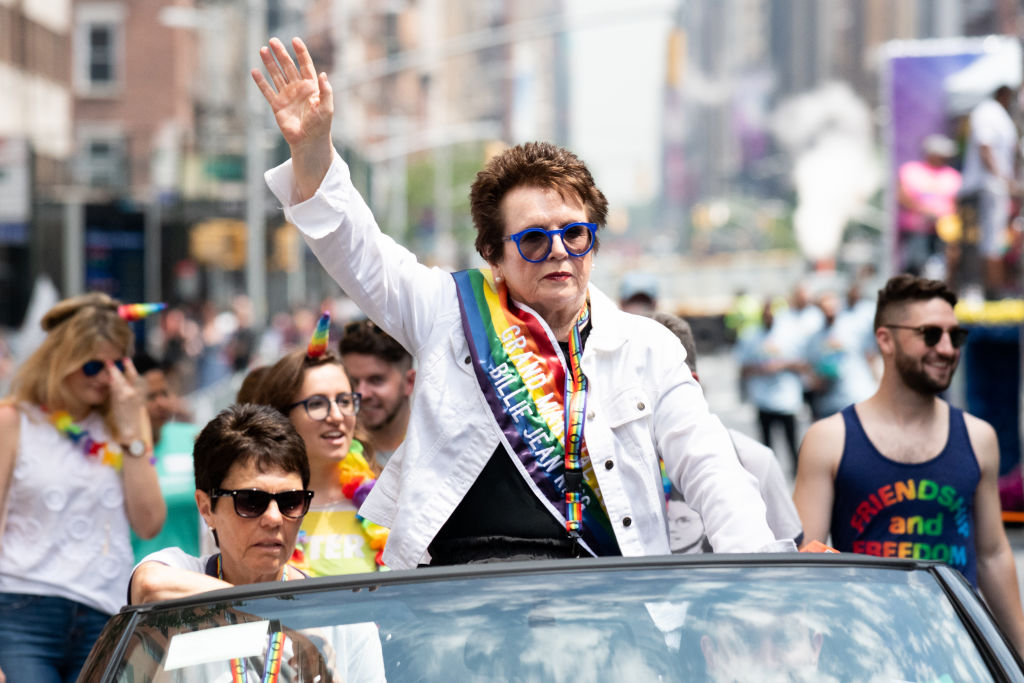Is U.S. society ready to let sports challenge the gender binary and male dominance, rather than reinforce them?

Editor’s note: This story also appears in the Summer 2023 issue of Ms. magazine. Join the Ms. community today and you’ll get the Summer issue delivered straight to your mailbox.
In the U.S., 57 percent of avid sports fans and 40 percent of the general population would like to see more opportunities for women and men to compete together and against one another in professional sports, a recent Seton Hall Sports Poll found.
When asked about the poll’s findings, feminist icon and tennis great Billie Jean King responded, “I have been suggesting this my whole life.”
So why isn’t there more gender integration in competition? King explained that people are too comfortable with what is because they love it and understand it. Imagining something new is uncomfortable. “I say get comfortable with being uncomfortable,” she said.
Of course, in many ways, we’re only talking about elite levels of play. After all, women and men often play together in recreational play in communities around the country. But there’s something else at play—pardon the pun—when we think about more elite competition, as we move from high school to college to professional sports, that keeps society holding on to gender segregation for dear life.
Still, Billie Jean King isn’t the only one who thinks sports should be more gender-integrated. Many sociologists of sports and feminists agree. Why? Let me break it down for you.

What’s the Problem with Gender Segregation in Sports?
Sports as we know them in the 21st century are rooted in the maintenance of rigid gender distinctions, heteronormativity and white male dominance.
Modern American sports trace their roots to the Second Industrial Revolution in the mid-1800s and early 1900s. At that time, many people left rural farm life for manufacturing jobs in cities. Unlike agricultural work, the regularity of work in factories left time for leisure.
Factories also helped create a strict gendered division of labor, with men moving outside the home for paid work in the factories and women staying home doing mostly unpaid and invisible labor.
As fathers went to work and left boys at home with their mothers, they began to worry that their sons would become feminized. These “soft” boys would then create a weak society.
At the same time, the burgeoning women’s movement threatened men, making them afraid of losing power.
All of this created a crisis in masculinity and a moral panic that dominating mothers would make their sons gay.
The answer to the problem was organized, competitive team sports.
Why? Sports helped socialize boys into their roles as future factory workers. In sports they learned discipline, hard work, sacrifice and obedience. Sports also valorized the male body as superior to the female body. Boys’ and men’s displays of strength, speed and violence were proof of that superiority. Of course, this proof only worked if women were excluded from sports, so they had no opportunities to challenge men’s superiority.
So sports became the place where boys learned to be men, where they learned masculine behaviors, and where their superiority over girls and women was reinforced.
Sports valorized the male body as superior to the female body. Boys’ and men’s displays of strength, speed and violence were proof of that superiority.
Of course, this didn’t keep girls and women from playing sports. In the mid-19th century, basketball, bowling, softball and tennis were all popular with girls and women. Not surprisingly, however, many people worried about girls and women playing sports. Why?
They might become too competitive and less attractive to potential mates. They might harm their reproductive organs or experience hysteria from too much stress from competition. They might get hurt in some way that compromised their beauty. And, of course, what ever would they wear, especially if men were to watch?
These fears led to different rules for sports. When it came to basketball, for example, the women’s version had six players on each team with three forwards and three guards on each side of the court and no one crossing half-court.
On the other hand, some historically Black colleges and universities (HBCUs) did develop competitive women’s sports programs. After all, Black women were already excluded from notions of ideal (white) femininity that had to be preserved in white schools, so HBCUs were freer to offer competitive sports programs.
Even today when women’s sports participation is at its highest, society still holds men’s sports in higher regard. Think of the hierarchy of sports—football, men’s basketball, baseball. These are the sports that emphasize general differences between women’s and men’s bodies. These sports focus on strength and speed rather than finesse, extreme endurance and balance, sports skills that women’s bodies are generally better at than men’s.
All of this means that sports reinforce heterosexual white male dominance.
Men learn that to be on top is to meet expectations for masculinity through avoiding acting in any ways that can be considered feminine; to objectify women sexually; to embrace homophobia; and to dominate other men physically. By aligning themselves with athletes as fans and spectators, all men gain symbolic power over women. Because some men can beat all women at certain athletic activities, all men gain power over women by their association with other men.

Gender segregation then perpetuates gender differences by making us believe men and women are fundamentally so different they can’t even play sports together. Because we believe that, that’s what we see. Because we believe in gender differences, we see them. For example, if we watch girls and boys doing the exact same activity, we’ll notice the differences, not the similarities. We also maintain this illusion through the ways sports are constructed. For example, why do women only play best two out of three in tennis, while men play three out of five? Can women really not play five sets of tennis if necessary?
And the effects of gender segregation extend beyond sports. They expand into family and work, as the perceived superiority of men over women in sports justifies male privilege and dominance in other domains.
For women athletes, the privileging of men’s sports means people learn to devalue women’s athleticism and, by keeping women from playing with men, sports maintain the illusion that men are better than women. It means that women are excluded from the front offices, coaching and sports media on the whole.
It also means that homophobia has an incredible impact on women athletes. Often women athletes feel the need to be hyper-feminine. Lesbian and other queer athletes feel they need to be in the closet. Coaches may work to keep their programs from being seen as lesbian and institutions may prefer to hire men as coaches.
And, as we saw in the case of the Larry Nassar and U.S. gymnastics scandal, institutions are quite willing to throw women under the bus to protect the institution, programs and the men associated with them.

Gender-segregated sports also create harm for intersex and trans girls and women. Caster Semenya’s case illustrates the point. Semenya is an intersex runner who fought for years against gender-testing rules that eventually barred her from running her races because of her testosterone levels. Many states have passed legislation to exclude trans girls and women from competition. The arguments to do so are not actually based in research but rely on assumptions and stereotypes and are really about preserving the gender binary and male dominance.
What’s the Alternative?
Because sports historically have been socially constructed to highlight characteristics of male bodies and to preserve male dominance, sports can be reconstructed to be gender-integrated. In some instances, this isn’t even a stretch. Why, for example, is professional bowling gender-segregated? Shooting? Diving? Already many sports could be gender-integrated without much modification.
And, of course, women who can compete with men should be given that opportunity. If a woman can kick field goals or wrestle or hit a baseball, why not give her that opportunity if that’s what she wants to do?
Women who can compete with men should be given that opportunity.
More individually-tailored training for women may also help close the gaps between women’s and men’s performance in some sports. As women have gained more access to training in general, they have made progress in catching up with men in many ways, although, on average, women’s performance in strength and speed seems to top out at around 90 percent of men’s. More research needs to be done on training specifically for women—not surprisingly, most training research is done on men. If women have access to the same level of tailored training, they may start to close the gap even more.
Of course, it’s hard to imagine most existing sports as gender-integrated. After all, they were created for male bodies. Still, some modifications are possible—but society would have to change what it believes about what constitutes superiority to be able to see athletic excellence in women.
What if basketball required two or three women on the court for each team at all times? Imagine a starting five of A’ja Wilson, Kelsey Plum, Step Curry, Klay Thompson and Draymond Green, taking on a starting five of Sabrina Ionescu, Breanna Stewart, Kevin Durant, Chris Paul and Deandre Ayton.
Imagine relay races or swimming relays with gender-integrated teams. Gymnastics teams could be integrated in team competition even while keeping segregation for individual events, although perhaps women should be able to do pommel horse and men do balance beam. Perhaps a little tweaking to the rules and men and women could compete against one another in other gymnastics events.
More women in coaching may also increase gender-integration because they may be more likely to give other women an opportunity to play. Men coach men, and most men coaches have themselves been through these systems that simply reproduce themselves with all the same assumptions and biases about men’s and women’s athletic abilities. Women who are breaking into coaching men’s teams themselves could perhaps bring greater openness to seeing the athletic talents of other women (although, of course, this is never guaranteed).
Sports could keep gender-segregated categories and add a third category that’s mixed. Or, in a truly revolutionary move, the creation of new sports that start in gender-integration could build on both men’s and women’s athletic strengths. These sports could be created with ideals of inclusivity and gender-integration at the core.
People of all genders can and do play sports together in a lot of ways. The real question is whether or not society is ready to let sports start to challenge the gender binary and male dominance rather than reinforce them.
Up next:
U.S. democracy is at a dangerous inflection point—from the demise of abortion rights, to a lack of pay equity and parental leave, to skyrocketing maternal mortality, and attacks on trans health. Left unchecked, these crises will lead to wider gaps in political participation and representation. For 50 years, Ms. has been forging feminist journalism—reporting, rebelling and truth-telling from the front-lines, championing the Equal Rights Amendment, and centering the stories of those most impacted. With all that’s at stake for equality, we are redoubling our commitment for the next 50 years. In turn, we need your help, Support Ms. today with a donation—any amount that is meaningful to you. For as little as $5 each month, you’ll receive the print magazine along with our e-newsletters, action alerts, and invitations to Ms. Studios events and podcasts. We are grateful for your loyalty and ferocity.





